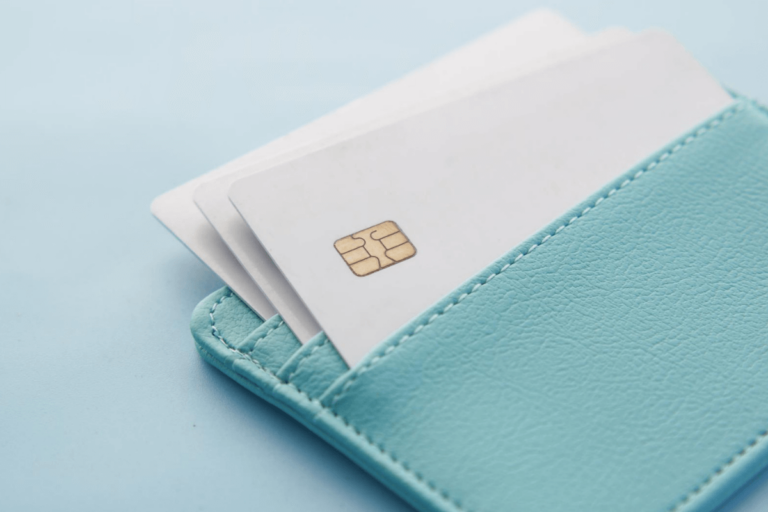4 Smart Tips to Handle Overwhelming Credit Card Debt

You know which three little words no one wants to hear? Credit card debt. It can go from zero to thousands with one quick swipe or build at a slow creep—a nice dinner here, a trip to the mall there, a gas fill-up to get you through until payday—and before you know it you could be staring at a credit card balance that’s a lot higher than you thought it was.
For Alicia Hintz, a member of the SoFi community, the debt creep started in 2016 with a large and unexpected loss of income—the day before she and her husband were to leave on their honeymoon. (Thanks, universe.)
Prior to that, they’d been toying with the idea of selling their Minneapolis home and moving closer to family in Wisconsin. The income reduction sealed the deal. But their house needed some work to be market-ready. The total bill was more than their savings, and their income wasn’t enough to pay in cash, so to the plastic they went.
For them the improvements were worth the investment—in that they sold their house for more than they paid for it, but almost every penny of it went toward fees, commissions, closing costs, and other expenses.
Alicia’s financial journey is likely to resonate with the 41.2% of American households that carry an average of about $9,300 in credit card debt, according to data reported by the Federal Reserve for Outstanding Revolving Debt. The statistics are sobering to be sure, but here’s a spoiler alert—thanks to some smart planning and a lot of stick-to-it-iveness, Alicia’s story ends on a high note.
4 Debt Payoff Strategies
Fast forward a few months and Alicia and her husband live in Wisconsin but on a much-reduced budget. In fact, it would be six more months before they were able to get their finances back up and running—that’s a lot of time for savings to shrink and debt to grow.
1. Zero Interest Credit Card
To try and combat the loss of income, Alicia opened a 0% interest (also known as a deferred interest) credit card with plans to pay it off within the year. “Before I opened that card, I had always paid off my credit card balance each month in full,” she said in a written interview with SoFi.
But, as is life, things didn’t go as planned. “The first month I didn’t pay off my full balance made me panic,” said Alicia. And on top of day-to-day financial challenges, the couple was invited to a destination wedding in the summer of 2017. In order to get the discounted room rate, they had to pay upfront for the flight and resort—close to $5,000.
“That extra money added to our credit card debt was a steep mountain to climb,” Alicia said. “After we had to pay that, I knew it would be years to get everything paid off.”
A 0% interest promotional period on a new credit card can last as long as 18 billing cycles , which could be a long enough time to make a large dent in the card’s principal balance.
But once the promo period expires, the interest rate can climb to as much as 27% (or higher). A credit card interest calculator can give you an idea of how much that rate will affect your total balance, and it’s important to consider whether you can achieve your payoff goal before the rate rises.
2. Creating a Debt-Focused Budget
Tackling a large credit card bill isn’t likely to be easy, so an important part of the process could be a hard look at what putting extra money toward credit card bills means for the rest of your budget.
One way to make this task easier on yourself is to download an app like SoFi Relay, which pulls all of your financial information into one place.
Your next step might be to focus on your spending. You may see obvious areas where you can cut back, or see if you can get creative to come up with some extra cash flow each month.
“We definitely tried to eat out less and cut back on shopping for clothes,” Alicia said. “But it seemed like every month there were more unexpected expenses that needed to be put on the credit card.”
From there, you can start to focus on a plan that makes credit card payments as equally important as the electric bill. And while you may not be able to pay more than the minimum on all your cards, it’s important to ensure that you pay at least that much if you want to avoid accumulating additional debt.
That’s because, while paying only the minimum can lead to compounded interest rates and larger overall balance over time, skipping payments can also lead to higher, penalty interest rates, late payment fees, and can even affect your credit.
3. The Snowball, The Avalanche and The Snowflake
The snowball and avalanche debt repayment strategies take slightly different approaches to pay down debt, and both involve maintaining the minimum payment on all but one card.
The debt snowball method focuses on the debt with the lowest balance first, regardless of interest rate, putting extra toward that payment each month until it’s paid off.
Then, that entire monthly payment is added to the next payment—on top of the minimum you were already paying. Rinse and repeat with the next card, and it’s easy to see how this method can quickly get the (snow)ball rolling.
The debt avalanche is based on the same philosophy but targets the highest-interest payment first. Getting out from under the highest debt can save a lot of money in the long run, and just like the snowball method, applying that entire payment to the next-highest-interest debt can lead to quick results.
The third snow-related strategy, the debt snowflake, emphasizes putting every extra scrap of cash toward debt repayment. This method played an active role in Alicia’s debt-elimination strategy. “If you have extra money to throw at your loans, even $20, that can still make a difference in your overall amount owed,” she said.
4. Personal Loan
As Alicia’s credit card utilization went up, her credit score went down. She decided to research her options and was ultimately approved for a SoFi credit card consolidation loan at a considerably lower interest rate than her credit cards, which along with making extra payments, helped save her money in the long run.
Over the course of those years, her husband took a new job, and they both changed cars, bought a house, and had a baby. They also went to two more destination weddings. This time, though, the extra expenses didn’t derail the plan.
“The loan was paid off within two years,” she said, thanks in part to a conservative budget and using an annual work bonus as a snowflake to make a dent in the balance.
From Someone Who’s Been There
One of the biggest things to remember, Alicia said, is that debt elimination doesn’t happen overnight. “Paying off debt is hard work,” she said. “Take it one month at a time. Some months are easier on your wallet, and others are not—looking at you, December!”
She suggested using the time you’re working to pay off debt to develop good budgeting and spending habits so that your post-debt finances are about saving, not spending.
And another tip from Alicia? Celebrate even the little victories. “When I paid off half my SoFi loan, I celebrated by taking a nice long bath,” she said.
When they reached zero balance, she and her husband went out for ice cream. “You can celebrate by going to the park with your kids, reading an extra chapter in a book, or finding a new series to watch,” she said. “Always celebrate your loan payoffs, no matter how small!”
Disclosures:
External Websites: The information and analysis provided through hyperlinks to third party websites, while believed to be accurate, cannot be guaranteed by SoFi. Links are provided for informational purposes and should not be viewed as an endorsement.
Financial Tips & Strategies: The tips provided on this website are of a general nature and do not take into account your specific objectives, financial situation, and needs. You should always consider their appropriateness given your own circumstances.
Member Testimonials: The savings and experiences of members herein may not be representative of the experiences of all members. Savings are not guaranteed and will vary based on your unique situation and other factors.
SoFi Loan Products
SoFi loans are originated by SoFi Lending Corp. or an affiliate (dba SoFi), a lender licensed by the Department of Financial Protection and Innovation under the California Financing Law, license # 6054612; NMLS # 1121636
. For additional product-specific legal and licensing information, see SoFi.com/legal.
SoFi Invest®
The information provided is not meant to provide investment or financial advice. Investment decisions should be based on an individual’s specific financial needs, goals and risk profile. SoFi can’t guarantee future financial performance. Advisory services offered through SoFi Wealth, LLC. SoFi Securities, LLC, member FINRA / SIPC . The umbrella term “SoFi Invest” refers to the three investment and trading platforms operated by Social Finance, Inc. and its affiliates (described below). Individual customer accounts may be subject to the terms applicable to one or more of the platforms below.
SOPL19046
This article is on SoFi.





